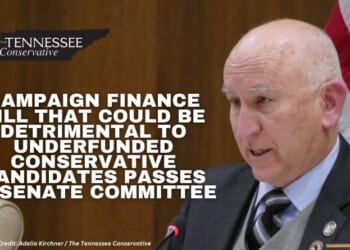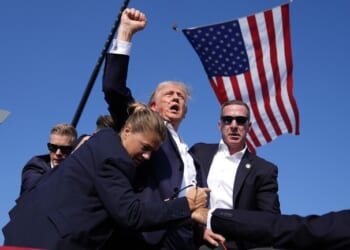This year, instead of the most-read articles of the year, the team have picked their favourites of the 1,500 or so we have published in 2024. They will appear in no particular order until New Year’s Eve. Today’s choice was first published on March 14, 2024.
ONE of the final acts of the Vaccine Taskforce before it was stood down was brokering a £1billion ten-year partnership between the UK Government and Moderna. This was effected under the chairmanship of Sir Richard Sykes, a former executive at Glaxo Wellcome, who replaced the original taskforce head, Dame Kate Bingham, a life sciences venture capitalist and managing partner of SV Health Investors, owner of DDF (Dementia Discovery Fund) which received a $50million investment from the Bill & Melinda Gates Foundation in 2018.
Announcing the deal on December 22, 2022, the Government told us that ‘the Vaccine Taskforce and Moderna have worked tirelessly to develop this deal to provide onshore capability and supply resilience’.
Under the terms of this partnership, Moderna is ‘committed’ to building a £150million ‘UK Innovation and Technology Centre’ with the capacity to churn out 250million doses of mRNA vaccines annually. That such a major health investment agreement has been made without being subjected to Parliamentary debate or scrutiny, while a mountain of evidence is building to bring the safety, efficacy and durability of these novel technology gene therapies into question, appears to have escaped media attention.
Last week the Times simply reported the Government’s announcement that the new facility is to be constructed in Harwell, Oxfordshire, beginning this year in time for a 2025 grand opening. This is where Sir John Bell’s ‘HealthTec Cluster’ in the Science and Innovation Campus is sited. It is also the home of the more recent Vaccitech of which Professor Adrian Hill, Director, Jenner Institute, University of Oxford, is the director and co-founder, the other co-founder being Dame Sarah Gilbert of the failed AstraZeneca vaccine and Barbie doll fame (the quiet withdrawal of this vaccine across Europe and the UK appears not to have held her back). Hill boasts of a business plan that has turned an Oxford University Lab into a ‘global lifesaver’ in one year. It has certainly attracted a lot of investment.
Forecasting the UK Moderna development in June last year, Fierce Pharma commented: ‘Over the course of the Covid-19 pandemic, Massachusetts mRNA upstart Moderna has pivoted from clinical-stage biotech to commercial juggernaut, charting several transatlantic manufacturing expansions along the way. Now, the company is laying the groundwork for the next leg of its production journey, which will be based in the United Kingdom.’
To date the UK government has refused to reveal exactly how much public money it has committed to the partnership. The hedge fund of which Prime Minister Rishi Sunak was a founding partner, Theleme Partners, is heavily invested in Moderna, although it denies that he retains any financial interest in it.
However the UK government has promised that the UK Health Security Agency (UKHSA) will be ‘working with Moderna to ensure early vaccine development, supporting the G7 mission to get from variant to vaccine in 100 days’ in order to ‘further future proof the UK against potential pandemics’ so that ‘NHS patients benefit from speedy access to the latest advancements in vaccine technology’.
From Stephane Bancel, Chief Executive Officer of Moderna, we learn that ‘our new state-of-the-art facility will bring mRNA manufacturing to UK shores, providing the UK public with access to pandemic response capabilities through Moderna Covid-19 vaccines and future respiratory virus vaccine candidates’ (my italics).
With this help from the UK government and the unsuspecting UK tax payer, Bancel can look forward to Moderna ‘expanding our clinical trial footprint across the country’.
Prominent amongst these ‘future respiratory virus vaccine candidates’ is one for Respiratory Syncytial Virus (RSV) which usually produces symptoms similar to the common cold but is prone to causing nasty asthma-like respiratory infections in young children and the elderly which can lead to hospitalisation.
In fact RSV is a showcase for how lockdowns and social distancing measures, the now-infamous ‘non-pharmaceutical interventions’, are the gifts that keep on giving to vaccine manufacturers.
In August 2021, the US Food and Drug Administration (FDA) announced that it had granted Moderna ‘fast track designation’ for mRNA-1345, its RSV vaccine candidate, which as Moderna explained is a designation ‘designed to facilitate the development and expedite the review of therapies and vaccines for serious conditions and that fill an unmet medical need’.
CEO Bancel said: ‘We are pursuing an mRNA RSV vaccine to protect the most vulnerable populations – young children and older adults. We are studying mRNA-1345 in these populations in an ongoing clinical trial and we look forward to sharing data when available. The Fast Track designation for older adults underscores the urgent need for a vaccine against RSV.’
In September 2022, the UK Health Security Agency began warning that its surveillance data showed that the lack of routine exposure to the virus had reduced natural immunity levels to RSV in young children resulting in ‘an unprecedented summer surge of RSV activity in 2021’. That these unnecessary interventions have created more illness, and more severe illness, shockingly has provided a rationale for what manufacturers doubtlessly expect to be another vaccine bonanza, when the answer of course is routine natural exposure and no more damaging lockdowns.
On January 17 this year Moderna announced it would be seeking regulatory approval for mRNA-1345, its RSV vaccine candidate which it claimed to be 83.7 per cent effective against RSV associated lower respiratory tract disease which they said typically afflicted 60,000 to 120,000 adults in the US (population 336million) each year, causing 6,000 to 10,000 deaths.
A fortnight later, on January 30, the FDA co-operatively announced it had granted a ‘breakthrough therapy’ designation for this vaccine candidate, which ‘expedites the development and review of drugs that are intended to treat a serious condition, and when preliminary clinical evidence indicates the drug or vaccine may demonstrate substantial improvement over available therapy on a clinically significant endpoint(s)’. In straightforward language, expect it to dodge the normal safety trials and timescales required for authorisation.
Prior attempts at developing vaccines against RSV had a problem common to coronavirus vaccine development. The vaccines overstimulated recipients’ immune systems, causing them to malfunction and resulting in them developing more severe respiratory disease on subsequent exposure – a phenomenon known as VAERDS (Vaccine Associated Enhanced Respiratory Disease). They were demonstrably not safe therapy, yet another reason why it is reckless to shorten the clinical trial process for vaccine development.
Moderna’s efforts to develop an RSV vaccine dates back to its collaboration with Merck and Co, an established vaccine developer and manufacturer, to boost its expertise in infectious diseases, which began in January 2015. Under this 2015 Master Collaboration agreement, Merck was paying Moderna to develop an RSV vaccine (mRNA-1777) and a second vaccine candidate, mRNA-1278, which Moderna said was a shingles vaccine. The agreement called for Merck to commercialise the vaccines and pay Moderna royalties.
When Moderna made its stock market debut in November 2018, it announced that ’On the basis of the Phase 1 results for the RSV vaccine (mRNA-1777), Merck has initiated planning for a Phase 2a clinical trial. We are working with Merck to identify and advance improvements to the RSV vaccine.’
mRNA-1777 was intended to be a single dose vaccine and was designed with a stabilised Prefusion F-protein, a technique developed by Dr Barney Graham, the then Deputy Director of the US National Institute for Allergy and Infectious Disease (NIAID) Vaccine Research Centre. As the contractual documents obtained by Axios News show, the NIAID licensed RSV patents to Moderna in January and October 2018.
It’s in May 2019 that things become curious. Just prior to Moderna signing a Research Collaboration Agreement on MERS and Nipah virus with the NIAID, Moderna reported in its quarterly filing with the securities regulator that an amendment was agreed to the 2015 Master Collaboration agreement. It stated ‘We and Merck agreed to certain exceptions to the existing exclusivity obligations, pursuant to which we will no longer be restricted from researching, developing, and commercializing an mRNA investigational medicine for the prevention of a specific set of respiratory infections, including RSV, for the pediatric population.’
Moderna said Merck was returning the rights to mRNA-1278, the purported shingles vaccine, which was then in preclinical development. Merck then elected to run a Phase 1 clinical trial of its own on a new RSV candidate, mRNA-1172, in the US, which Moderna paid Merck to conduct. Moderna subsequently added mRNA-1345 to its product development pipeline, saying it was a paediatric RSV vaccine.
The story is to get murkier.
Buried in the Exhibits attached to the 2018 Moderna stock market prospectus are copies of the 2015 Master Collaboration Agreement with Merck and a series of earlier amendments to it. Moderna requested confidential treatment of parts of these contracts until 2028.
In Amendment 1 made in January 2016, Moderna asked Merck to ‘substitute VZV’ (varicella-zoster virus) for something else which was redacted. Having agreed to this, Merck sought a second Amendment in June 2016 giving it the right to elect new products which it exercised in May 2019 when it nominated mRNA-1172.
In 2020, the jointly-owned Moderna-NIAID vaccine for SARS CoV2 was given the identifier mRNA-1273. In March 2022, Moderna announced that it was developing a new pan-coronavirus vaccine candidate, mRNA-1287, to counter the common cold. The obvious inference is that mRNA-1278, the vaccine which Moderna claimed publicly in 2018 and 2019 was a shingles vaccine candidate, was in fact a coronavirus vaccine and that VZV was ‘substituted’ in name only as Moderna wished to keep the development of this vaccine secret. Moderna needed to extricate itself from its agreement with Merck before it could pursue the NIAID project in the latter half of 2019.
Under the 2015 Master Agreement, Merck would have had to commercialise the mRNA-1278 vaccine and pay Moderna royalties, so either Moderna got greedy and wanted all the profits or Merck, knowing Moderna had misled the public, had misgivings about agreeing to ‘substitute VZV’. Having given itself the ability to conduct due diligence of its own on the mRNA products made by Moderna, Merck ran its own trial on the second RSV candidate, mRNA-1172, and in October 2020 it returned all rights to Moderna. Moderna put out a press release saying it had ‘regained the rights to RSV (mRNA-1172) from Merck including for adult populations’.
On December 2, 2020, the day the UK Medicines and Healthcare products Regulatory Agency (MHRA) issued a Temporary Use Authorisation (TUA) for Pfizer/BioNTech’s mRNA Covid-19 vaccine, Merck issued a press release of its own announcing that it had divested from Moderna but that it ‘retains exposure indirectly to Moderna through its holding in venture funds’.
The US FDA granted Moderna an emergency use authorisation on December 18, 2020, a week after it followed the MHRA lead in giving Pfizer/BioNTech an emergency use authorisation.
As the extended agreement between Moderna and Merck was meant to run until 2022, it appears that Merck, having done its due diligence on mRNA-1172, used the material breach clause of the contract to exit.
Urgent questions need to be asked of the UK government as to how much taxpayer money has been committed to the Moderna partnership and whether the Vaccine Taskforce that brokered the deal did any due diligence.










